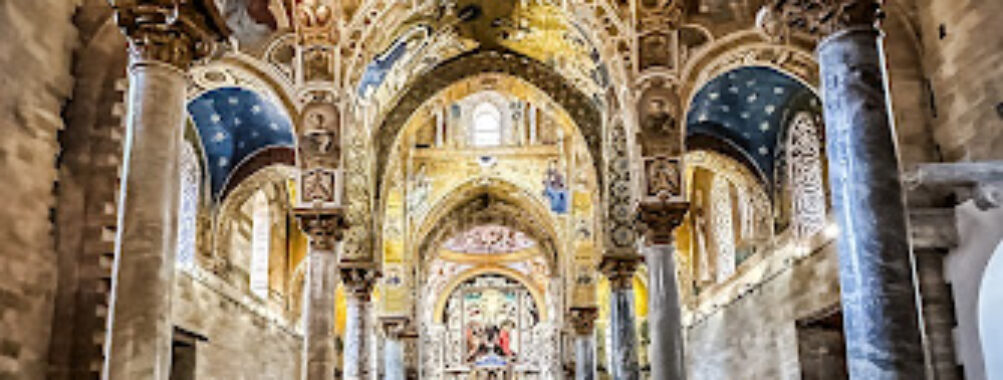
Church of Saint Mary ‘dell’Ammiraglio’
Table of Contents
Description
The Church of Saint Mary dell’Ammiraglio, often affectionately referred to as La Martorana, is one of those places that manages to surprise even the most seasoned traveler. Standing proudly in Palermo’s historic heart, it’s a church that wears its layered history on its walls—literally. Built in the 12th century by George of Antioch, the admiral of King Roger II, it was originally a Norman church infused with Byzantine artistry. Over the centuries, it was reshaped and touched by Baroque influences, so when you step inside, you’ll see a tapestry of styles that somehow coexist in harmony. It’s a little chaotic, yes, but in the most beautiful way possible.
What makes this church stand out isn’t just its architectural pedigree but the way it feels alive with stories. The Byzantine mosaics shimmer in gold and deep blues, depicting Christ, angels, and saints in a way that seems to pull you back nearly 900 years. I remember the first time I walked in, I had to stop in the doorway because the ceiling alone was overwhelming. And then, just when you think you’ve seen enough, you notice the Baroque stuccoes and frescoes that were added later, almost like another layer of personality. Some people might find the clash of styles odd, but to me, it’s like Palermo itself—complex, layered, and unapologetically bold.
Visitors often rave about its beauty, though not everyone is blown away. A few find it crowded or not as large as they expected, but most agree the mosaics are worth the visit alone. If you’ve seen the great cathedrals of Monreale or Cefalù, you’ll recognize the same golden glow here, just on a more intimate scale. And that intimacy is part of its charm. You’re not just looking at history—you’re standing in a living church where the Italo-Albanian Catholic community still celebrates the Byzantine Rite in Greek and Albanian. That’s something you don’t find just anywhere in Europe.
Key Features
- 12th-century Byzantine mosaics, including a famous image of Christ Pantocrator
- Blend of Norman, Arab, Byzantine, and Baroque architectural influences
- Active Italo-Albanian Catholic parish using the Byzantine Rite
- Stunning dome and intricate marble floors
- Baroque frescoes and stuccoes from later renovations
- Part of the UNESCO World Heritage route with Monreale and Cefalù cathedrals
Best Time to Visit
If you’re like me and prefer to avoid elbowing your way through crowds, mornings are the sweet spot. Arriving just after opening gives you the chance to soak in the mosaics in relative quiet. The golden tiles catch the morning light in a way that feels almost otherworldly. Weekdays are generally calmer than weekends, though Palermo is never exactly sleepy. Spring and autumn are ideal seasons—the weather is pleasant, and you won’t be battling the summer tour groups. That said, if you’re visiting in winter, don’t dismiss it. The church feels especially atmospheric on a cool, grey day when the mosaics seem to glow even brighter against the dim light.
How to Get There
The church is located right in the historic core of Palermo, so chances are you’ll stumble upon it while exploring Piazza Bellini. If you’re staying nearby, it’s a short walk from most central accommodations. For those coming from further out, buses and taxis can drop you close to the square. Honestly, though, Palermo is best explored on foot, and wandering the narrow streets until you suddenly find yourself in front of La Martorana is half the fun. Just be prepared for uneven cobblestones—wear shoes that won’t leave you regretting your life choices after a few hours.
Tips for Visiting
First off, give yourself time. It’s tempting to rush in, snap a few photos of the mosaics, and move on, but the real magic comes when you slow down. Sit on a pew for a few minutes and let your eyes wander—you’ll keep discovering new details. If you’re a photography enthusiast, bring a camera that handles low light well, because flash photography is usually not allowed. And remember, this is an active place of worship, so dress respectfully and be mindful if a service is taking place.
Accessibility can be a bit tricky. There isn’t dedicated wheelchair-accessible parking right at the site, and amenities like restrooms aren’t available inside, so plan accordingly. I’d recommend combining your visit with the nearby churches of San Cataldo and Santa Caterina—they’re all in the same square and create a fascinating contrast. And if you’re hungry afterward, the surrounding streets are packed with little trattorias where you can grab a plate of pasta con le sarde or an arancina. Trust me, nothing pairs with Byzantine mosaics quite like Sicilian street food.
Ultimately, the Church of Saint Mary dell’Ammiraglio isn’t just another monument to tick off a list. It’s a place where cultures, faiths, and centuries collide in a way that feels uniquely Sicilian. Some visitors will leave dazzled, others perhaps puzzled, but few walk out untouched. If you’re in Palermo, don’t just pass by—step inside and let it work its quiet magic on you.
Location
Places to Stay Near Church of Saint Mary 'dell'Ammiraglio'
Find and Book a Tour
Explore More Travel Guides
No reviews found! Be the first to review!